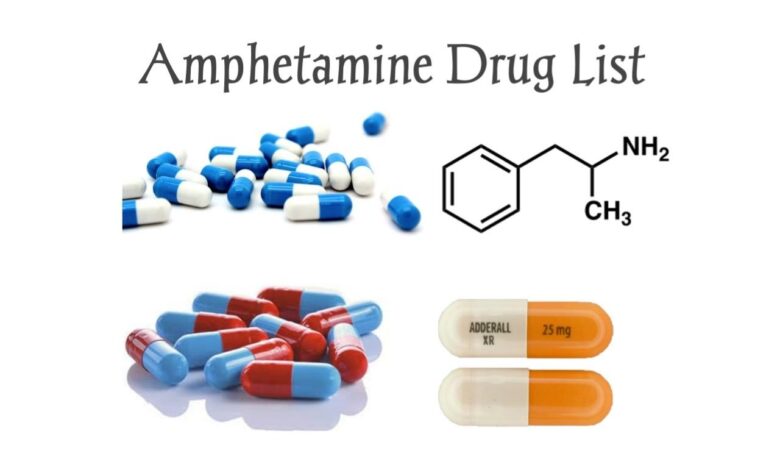Amphetamine Drugs List

What are amphetamines?
Amphetamines are a class of psychostimulant drugs named after the prototypical agent, amphetamine, a phenethylamine derivative. They work by activating receptors in the brain and increasing the activity of a number of neurotransmitters, especially norepinephrine and dopamine. Dopamine is associated with pleasure, movement, and attention.
Amphetamine exists as two enantiomers: levoamphetamine and dextroamphetamine. Amphetamine properly refers to a specific chemical, the racemic free base, which is equal parts of the two enantiomers in their pure amine forms. Studies indicate that L-Amphetamine improves poor sustained attention while D-amphetamine reduces overactivity and impulsiveness as well as improves sustained attention.
Available amphetamines include both prescription and illicit chemicals. Prescription amphetamines are FDA approved for conditions such as attention deficit hyperactivity disorder and are popularly prescribed. They are controlled substances due to their abuse potential. Examples include methylphenidate and dextroamphetamine. Methamphetamine is an example of an illicit amphetamine that is commonly abused. Designer amphetamines (or synthetic amphetamines) include analogs of amphetamine and a type of amphetamine called cathinone or a beta-keto amphetamine. Cathine or beta-keto amphetamine is found in nature as a constituent of the plant Catha edulis and it is chewed for its stimulant properties.
The amphetamines exert their pharmacological effect by increasing the release and decreasing the reuptake of catecholamines (including norepinephrine and dopamine). This mechanism is the reason for the clinical effects as well as the addictive properties of these drugs.
The onset of effect and duration of effect after amphetamine use depends on the route of administration as well as the specific agent abused. Amphetamines can be smoked, inhaled, injected, or ingested. Methamphetamine’s effect can last 12–24 h whereas immediate-release oral methylphenidate may only last for 6 h.
What are they used for?
Some types of amphetamines are prescribed by doctors to treat conditions such as attention deficit hyperactivity disorder (ADHD) and narcolepsy (where a person has an uncontrollable urge to sleep). Amphetamines have also been used to treat Parkinson’s disease. Other types of amphetamines, such as speed, are produced and sold illegally. Amphetamines have also been taken as performance enhancement drugs. The most potent form is crystal methamphetamine (ice).
Amphetamines are stimulants used for ADHD. They include:
• amphetamine
• lisdexamfetamine
Amphetamine Drugs List
| Brand Name | United States Adopted Name | (D:L) ratio | Dosage form |
| Adderall | – | 3:1 (salts) | tablet |
| Adderall XR | – | 3:1 (salts) | capsule |
| Mydayis | – | 3:1 (salts) | capsule |
| Adzenys ER | amphetamine | 3:1 (base) | suspension |
| Adzenys XR-ODT | amphetamine | 3:1 (base) | ODT |
| Dyanavel XR | amphetamine | 3.2:1 (base) | suspension |
| Evekeo | amphetamine sulfate | 1:1 (salts) | tablet |
| Evekeo ODT | amphetamine sulfate | 1:1 (salts) | ODT |
| Dexedrine | dextroamphetamine sulfate | 1:0 (salts) | capsule |
| Zenzedi | dextroamphetamine sulfate | 1:0 (salts) | tablet |
| Vyvanse | lisdexamfetamine dimesylate | 1:0 (prodrug) | capsule |
| tablet |
You can also find useful information on Vyvanse vs Adderall: Differences and Similarities





